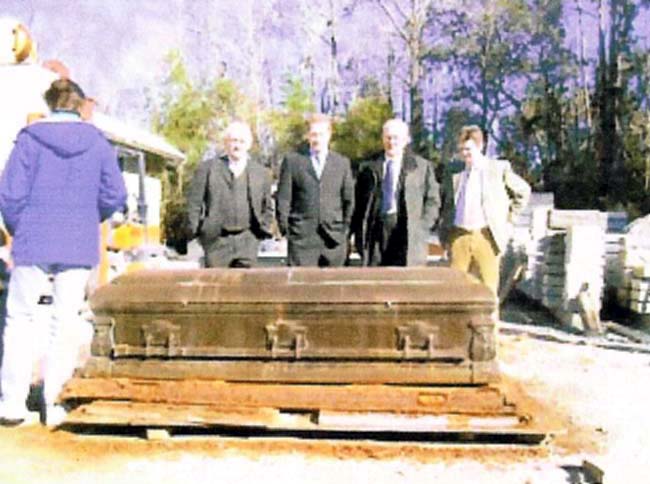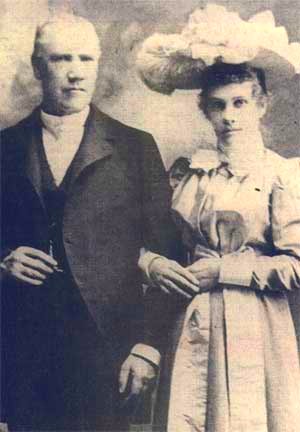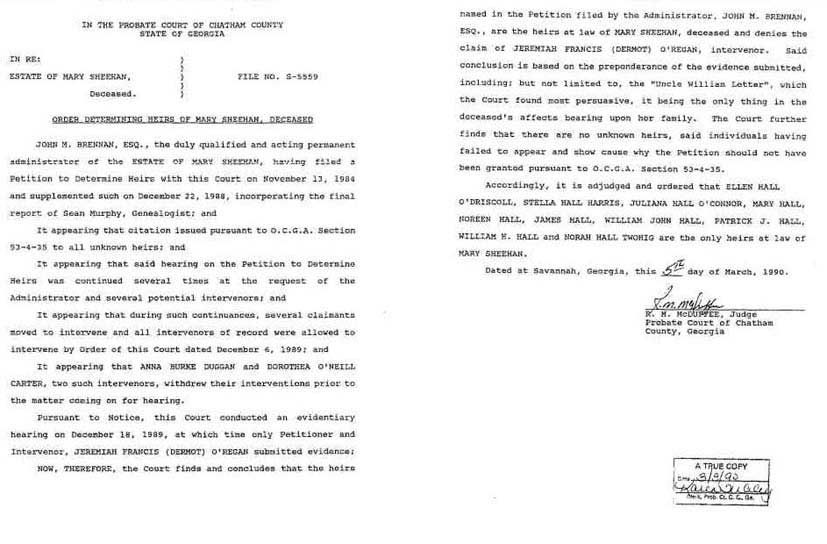Irish
Historical Mysteries: The Sheehan Intestacy Case

Exhumation
of the body of Ellen Sheehan at Bonaventure Cemetery, Savannah,
January 2004
The city of Savannah,
Georgia, is notable
for the beauty of its architecture, a certain air of mystery and
some colourful, not to say eccentric citizens. One of best known
of Savannah's characters was Jim Williams, a buildings preservationist
and
art dealer who was tried but acquitted three times for the murder
of his lover Danny Hansford, only to die suddenly himself in
1980. Williams is the anti-hero of John Berendt's haunting
factional novel, Midnight in the Garden of Good and Evil,
turned into an enthralling movie directed by Clint Eastwood.
Strange things happen in Savannah, and as we shall now see, few
can be stranger than the Sheehan intestacy case, which involves a
family of Irish origin, an unclaimed fortune left by its last
surviving member and a dogged campaign by an Irish claimant.
When Mary (Ellen) Sheehan died in
Savannah on 16 November 1983 she was to all appearances a poverty
stricken recluse, her food reportedly sometimes suspended by string
from the ceiling
of her home in York Street in order to keep it away from
the bugs. (1) Mary was the last of four unmarried children of
Savannah policeman William Sheehan and his wife Ellen Regan, and
after her death it became clear that she was in fact possessed of
significant wealth. William Sheehan had been born in County Cork,
emigrated to the United States and secured employment with the
Savannah police force. The city administration and its patronage
were controlled by a political machine headed by 'bosses', the
best known of whom was John Bouhan (1881-1971), also of Irish
extraction. Policemen in Savannah were not well paid, often
needing second jobs and reportedly sometimes succumbing to
temptations of bribery. (2) William Sheehan of course may simply have
been thrifty and a wise investor, but by the time of his death in 1922
he had amassed considerable wealth in
the form of properties in Savannah. William's wife Ellen Regan
was also an Irish immigrant from County Cork, and lived on in
Savannah until her death in 1941. Following the deaths of Mary
Sheehan's surviving siblings, the family
estate
passed to her.

William Sheehan and Ellen Regan
Mary Sheehan had no known
relatives in Savannah or the United States, so the administrators
of her estate, Bouhan, Williams and Levy, decided after her death
to extend the search to her parents' country, Ireland. This law
firm had been founded by the above mentioned John Bouhan and is
headquartered in the Armstrong House on Bull and Gaston Streets
in Savannah, a beautifully restored building which had been
purchased from Jim Williams. To complete the connection,
Williams's lawyer during the latter phase of his murder trials
was a partner in the firm, Frank 'Sonny' Seiler. (3) Bouhan,
Williams and Levy engaged a Cork law firm, Ronan, Daly, Jermyn,
to place advertisements in Irish newspapers, looking for anyone
who could prove a close relationship to Mary Sheehan's parents and
who would therefore have a claim on the estate. (4) Also prominent in
the search for Irish heirs was Fr Jeremiah McCarthy, a priest at the
Blessed Sacrament Church in Savannah.
The publicity campaign not
surprisingly attracted a lot of attention, and dozens of claims
had been received by Ronan, Daly, Jermyn by 1988. It was at this
point that the present writer became involved, being commissioned
to check the genealogical data of the claimants and report to
Bouhan, Williams and Levy in Savannah. While my particular
attention was directed to evidence supplied in relation to a
number of cousins of Ellen Regan surnamed Hall, I subjected all
the files forwarded to me to impartial analysis. I noticed that
one claimant in particular, Dermot O'Regan, a businessman based
in Ovens, County Cork, was particularly insistent, even going so
far as to forward a submission to me personally. (5)
The conclusion of my research was
that the Hall group of claimants had established the closest
documented relationship to William Sheehan's wife Ellen Regan,
specifically, that their grandfather Patrick Hall had in 1868
married Elizabeth Donovan, an aunt of Ellen. While Ellen had a
number of siblings, including a brother William, it appeared that
they had died without issue. Among Mary Sheehan's possessions in
Savannah was found a letter to her dated 14 April 1941 from a
William O'Regan in Gubbeen, Schull, County Cork, referring to her
mother's death and signed 'Your Uncle'. It was clear that
this must be Ellen's brother, who like many others had restored
the dropped 'O' prefix to his surname. Also presented to me was a
birth certificate for Ellen Sheehan, born 21 November 1864 in
Gubbeen to parents John Regan and Anne Donovan, which I
considered did indeed refer to Mary Sheehan's mother. Despite
my best efforts, I could find no relatives of Mary's father
William Sheehan, and although it was known that he was born in
County Cork about 1857-63 and that his father was also named
William, it was never established exactly where in the county his
family resided. (6)
I could not find that any of the
other claimants, including Dermot O'Regan, had documented a
relationship to Mary Sheehan. Assisted by his genealogist Jim
Herlihy, Mr O'Regan claimed that his grand aunt Ellen Regan, born
26 March 1882 in Bandon, was in fact the one who had married
William Sheehan in Savannah in 1898. It was stated that this
Ellen had added some years to her age when marrying William
Sheehan, and that on the other hand, the Ellen born in 1864 was
far too old to be the individual in question. I could not see
that any of the documentation presented by Dermot O'Regan proved
his case that his Ellen was the correct one. Genealogists learn
to expect fluctuations in stated ages, but these of course can go
in both directions. The children of William Sheehan and Ellen
Regan were born between 1901-06, when the Ellen born in 1864
would have between 37-42 years, not at all an impossible age
range for child bearing. (7)
I submitted a final report to
Bouhan, Williams and Levy on 28 November 1988, stating my opinion that
the Hall group of claimants were the closest located relatives to
the deceased Mary Sheehan, and on 18 December 1989 I gave testimony to
this effect by telephone to the Probate Court of Chatham County,
in which Savannah is located. The court issued an order on 5 March 1990
determining that the heirs of Mary Sheehan were the claimants in
the the Hall group, and furthermore the claim of Dermot O'Regan
was denied. This decision was based 'on the preponderance of the
evidence submitted, including but not limited to the "Uncle
William Letter", which the Court found most persuasive' (see
copy of order below).

Dermot O'Regan was by no means
content to accept this ruling, and he continued to press his
claim in the years that followed. Thus in a newspaper article on
the case in 1994, O'Regan and Jim Herlihy were quoted as still
casting doubts on the Savannah Probate Court verdict, alleging
that a crucial genealogist's report discounting the evidence
presented to the court had been suppressed. Claiming that he had
spent £100,000 in legal fees and expenses, O'Regan stated that
on the basis of the evidence gathered, he was 'absolutely
convinced' that Ellen Sheehan was his relative. (8) The courts
were not impressed
by the supposedly new evidence, so that the Savannah ruling on
the estate stood, and it seemed that the challenge could not be
maintained. Undaunted by the cost in time and money, O'Regan began
to press for exhumation of bodies in Savannah in an effort to
secure DNA evidence in support of his case. Having secured legal
sanction, in January 2004 the body of Ellen Sheehan was exhumed
in Savannah's historic Bonvaventure Cemetery. Bone samples were then
taken for analysis by Karen Burns of the University
of Georgia, a leading forensic
anthropologist. (9)
On the other side of the
Atlantic, an order was also obtained to exhume the body of Dermot
O'Regan's grandfather in St Finbar's Cemetery,
Cork, and further bone samples were passed to Burns in May 2004. (10)
The whole
process appeared, to say the least, somewhat unedifying, and in
Savannah Fr McCarthy was
quoted as commenting bluntly, 'Have
you ever seen such foolishness in your life?'. After a suspenseful wait
and to much less media fanfare,
Burns's
results were released in July 2004, and they proved to be . . .
negative. In short, the DNA
samples from Savannah and Cork did not
match. (11) The integrity of the Savannah Probate Court
decision, and the present writer's research, had thus been vindicated.
It has also emerged that the Sheehan Estate in Savannah was much more
modest than had been claimed, being in the region of hundreds of
thousands rather
than tens of millions of dollars. As they were legally obliged to
do, the
administrators had sold the estate after Mary Sheehan's death at then
market values, and the inflated total was inferred from later property
values.
There the matter might
have been expected to have been laid to rest, and the long running
story concluded
once and for all.
However, in a documentary on the case broadcast on Irish television in
January 2005, it was revealed that further exhumation orders may be
sought, in that it is alleged that the wrong bodies might have been
dug up! This documentary dealt with my research in a rather dismissive
way, and I was given no opportunity to put my point of view by way of
interview. (12) It is also relevant to point out that on several
occasions I have been promised copies of the supposedly conclusive
documentary evidence in support of Dermot O'Regan's claim, some of it
allegedly withheld during the Savannah court proceedings, but I
have yet to receive any such material. In these circumstances I feel
entitled to place the present factual account of the Sheehan case in
the public domain, particularly as one or perhaps two books on the
affair are promised. In conclusion, one can only hope that whatever
else happens, the dead
will not be further disturbed.
Sean J Murphy
30 May 2005
References
(1) 'Family unearths kin in quest for
fortune', Associated Press, Savannah, May 2004.
(2) Timothy Daiss, Rebels,
Saints and Sinners: Savannah's Rich History and Colorful
Personalities, Gretna, Louisiana, 2002, page 62.
(3) John Berendt, Midnight in
the Garden of Good and Evil: A Savannah Story, New York 1999
Edition, page 263 and following (factional account).
(4) 'Hunt for Irish heirs to huge
fortune as deadline nears', Irish Independent, 15
September 1987.
(5) Dermot O'Regan to author, 24
February 1989.
(6) There are about 50 County Cork
householders named William Sheehan listed in a mid-nineteenth
century property tax record (Family Tree Maker, Index to
Griffith's Valuation of Ireland, 1848-64, CD-ROM).
(7) Case files in writer's possession.
(8) Sunday
Independent, 20 March 1994.
(9) 'Body at Bonaventure
exhumed to prove lineage', Savannah
Morning News, 17 January 2004, online at http://savannahnow.com.
(10) 'We want to get to
the bottom of this', Irish Examiner,
15 May 2004.
(11) Irish Times, 23 July 2004.
(12) Liberty Films, The Family Silver, Radio
Telifís Éireann, 6 January 2005.
Back
to Irish Historical Mysteries: Contents



